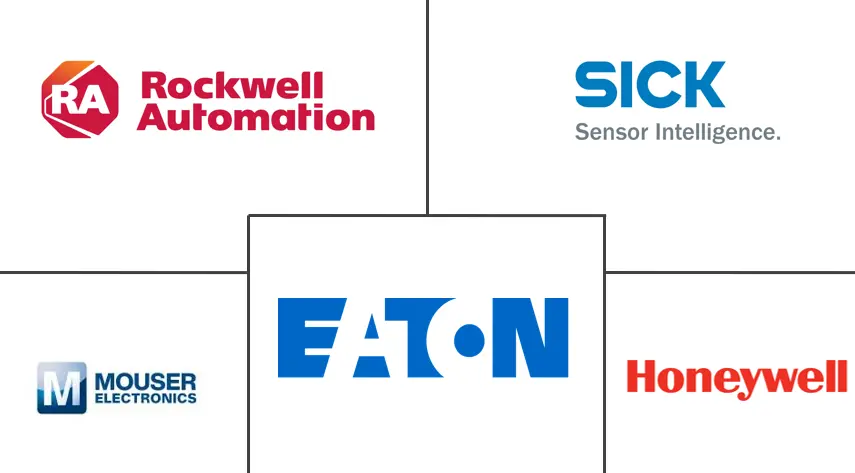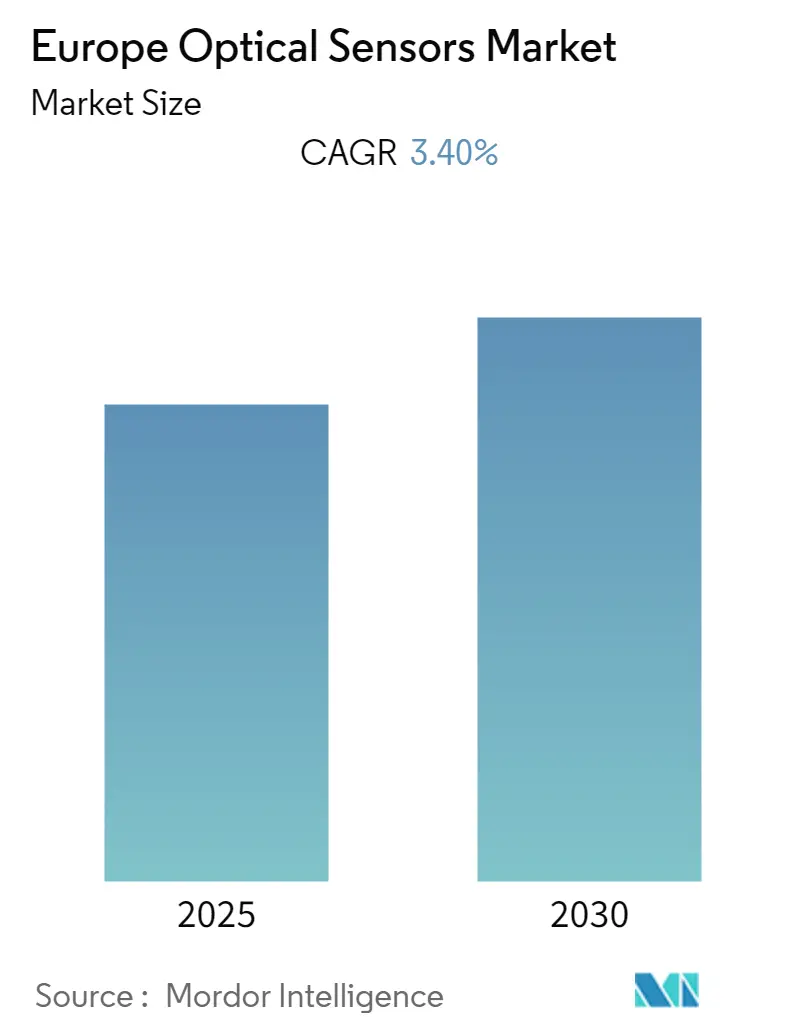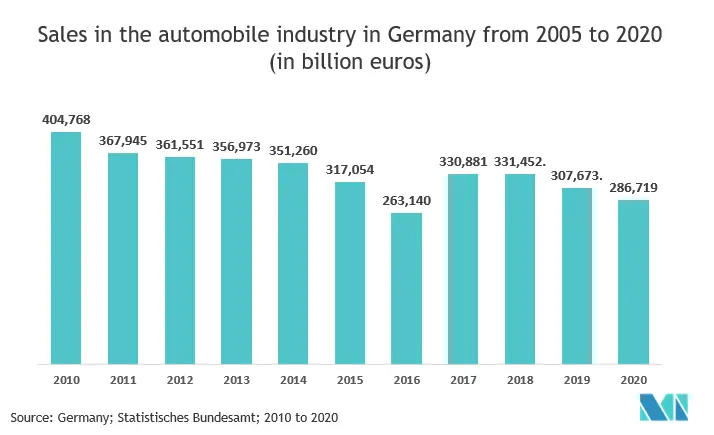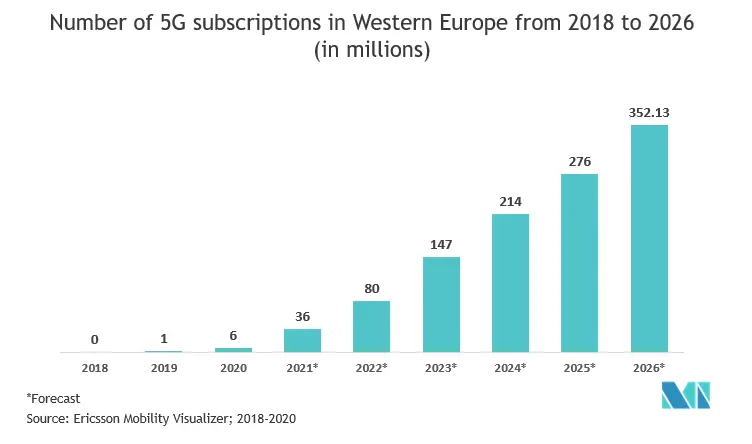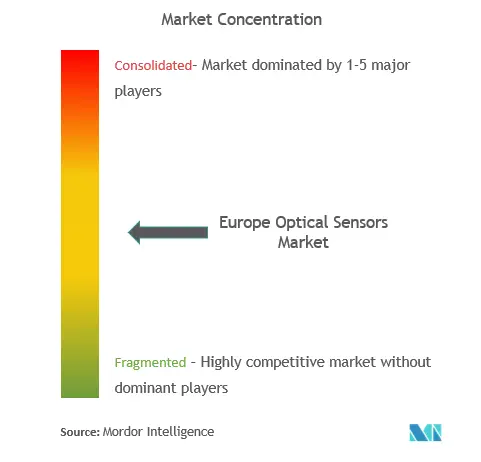Europe Optical Sensors Market Analysis
The Europe Optical Sensors Market is expected to register a CAGR of 3.4% during the forecast period.
- Also, the increasing demand for advanced security features in smartphones has led to features, such as on-screen fingerprint scan, an optical sensor that detects and verifies fingerprints, driving the fiber optic sensor market.
- Ambient sensors measure the light in the room and adjust the screen's brightness accordingly. Thus, the increasing demand for smartphones is expected to drive the demand for these sensors.
- Optical sensors are also becoming an indispensable tool for manufacturers to save power, time, and money, because of the rapid and precise measurements they provide. Moreover, as these sensors have applications in intelligent lighting, they help save power, as they do not rely on a manual on-off switch but turn on light according to the natural light in the premises.
- The imbalance between image quality and price has led to increased competition, particularly for the consumer electronics segment, which has some of the most established players facing peer pressure over optimal pricing. Several small players are also facing difficulty over product differentiation, which leads to a potential barrier for their entry into high-volume applications. In this case, successful product differentiation can move a product from pure pricing to non-pricing factors.
- Thus, companies are vying to overcome this challenge by focusing on advanced and efficient technologies that would help minimize sensors and superior performance. The increasing adoption of these sensors in non-traditional fields, such as automation (mobile robots), is expected to overcome this challenge.
- The COVID-19 pandemic has seriously impacted the semiconductor sector, curbing demand in the optical sensor industry. According to the Semiconductor Industry Association, semiconductor sales in the first quarter of 2020 fell 3.6% due to the severe disruption of international supply chain activities due to the COVID-19 pandemic. In addition, some major automotive and consumer electronics OEMs have shut down manufacturing operations due to various government blockade scenarios, resulting in lower sales of optical sensors.
Europe Optical Sensors Market Trends
Adoption of opical sensors in automobiles is expected to drive the market
- In the automotive industry, optical sensors are used in several camera-enabled systems, including autonomous driving, advanced safety systems, and in-vehicle infotainment (IVI) systems. These sensors provide a variety of intuitive features such as 3D gesture recognition, Vehicle-to-Everything (V2X) communication, and indoor lighting control applications.
- The growing development of ADAS and self-driving cars in Germany will accelerate market demand. Leading companies in the automotive industry, such as the BMW Group, have already begun developing fully autonomous models.
- In November 2020, Honda announced mass production of Level 3 self-driving cars with integrated sensor technology. Similar initiatives by automotive OEMs add opportunities for expansion to the market.
The ambient light and proximity sensor segment is expected to grow due to increase adoption of consumer electronics
- According to research, backlighting for displays is only required 40% of the time. Ambient light and proximity sensors (ALSs) have been suitable in offering power saving through automatic adjustment and improved backlighting solutions for hand-held electronic devices such as mobile phones, tablets, PDA's, among others. Recently ambient sensors for LCD TV displays have gained traction.
- A similar trend has started to attract applications such as home and automotive lighting solutions. For instance, the room's illumination can be changed through RGB ALSs that provide feedback to a room's lighting-control system to adjust the light color, intensity, and color temperature output of the LED-based luminaires.
- Also, automobile lighting can be adjusted to accommodate day or night driving or reflect the brightness of streetlights through intelligent ambient sensors that offer saving power and provide a better user experience.
- Optical proximity sensors have been integrated into almost every smartphone and touch-screen electronic device to enable gesture control, trigger and detection applications, and some industrial applications such as determining the number of production units in industrial applications, particularly in manufacturing process lines.
- The pandemic has caused significant setbacks as carriers struggle to deploy 5G networks. At the same time, pandemics are driving the demand for technology as people become more and more dependent on the Internet while working from home.
Europe Optical Sensors Industry Overview
The Europe optical sensors market is competitive and consists of several major players. These companies are leveraging strategic collaborative initiatives to increase their market shares and profitability.
- February 2020 - China International Optoelectronic Exposition reports that IRay Technology is manufacturing thermal imagers that incorporate optical sensors for real-time temperature detection of potential COVID-infected patients. Airports, train stations, factories, and hospitals are equipped with this imager that alerts to abnormal temperatures with alarms.
Europe Optical Sensors Market Leaders
-
Mouser Electronics
-
Sick AG
-
Rockwell Automation
-
Honeywell International Inc
-
Eaton Corporation PLC
- *Disclaimer: Major Players sorted in no particular order
Europe Optical Sensors Market News
- October 2020 - OMRON Corporation announced the global release of the new E3AS-HL CMOS laser sensor*2 equipped with the industry's first sensing technology that significantly improves detection capability. Reliable detection of hard-to-find targets eliminates the need for time-consuming installation design and adjustments in equipment commissioning without relying on human experience or skill.
- March 2020 - TE Connectivity Ltd has completed the public acquisition of First Sensor AG. TE currently holds a 71.87% stake in First Sensor. Combining First Sensor with the TE portfolio, TE has a broader product base that includes innovative, market-leading sensors, connectors, and systems, as well as best-in-class features that support TE's overall growth strategy connectivity. Offers. First Sensor offers market expansion opportunities in optical sensing applications for industrial, heavy trucks, and automotive.
Europe Optical Sensors Industry Segmentation
Optical sensors are used in various commercial and research applications, such as quality and process control, medico technologies, metrology, imaging, and remote sensing. R&D in the field is driven by the expectation that optical sensors will have significant advantages over the conventional sensor types in terms of their properties.
| By Type | Extrinsic Optical Sensor |
| Intrinsic Optical Sensor | |
| By Sensor Type | Fiber Optic Sensor |
| Image Sensor | |
| Photoelectric Sensor | |
| Ambient Light and Proximity Sensor | |
| Other Sensor Types | |
| By Application | Industrial |
| Medical | |
| Biometric | |
| Automotive | |
| Consumer Electronics | |
| Other Applications | |
| By Country | Germany |
| United Kingdom | |
| France | |
| Rest of Europe |
| Extrinsic Optical Sensor |
| Intrinsic Optical Sensor |
| Fiber Optic Sensor |
| Image Sensor |
| Photoelectric Sensor |
| Ambient Light and Proximity Sensor |
| Other Sensor Types |
| Industrial |
| Medical |
| Biometric |
| Automotive |
| Consumer Electronics |
| Other Applications |
| Germany |
| United Kingdom |
| France |
| Rest of Europe |
Europe Optical Sensors Market Research FAQs
What is the current Europe Optical Sensors Market size?
The Europe Optical Sensors Market is projected to register a CAGR of 3.4% during the forecast period (2025-2030)
Who are the key players in Europe Optical Sensors Market?
Mouser Electronics, Sick AG, Rockwell Automation, Honeywell International Inc and Eaton Corporation PLC are the major companies operating in the Europe Optical Sensors Market.
What years does this Europe Optical Sensors Market cover?
The report covers the Europe Optical Sensors Market historical market size for years: 2019, 2020, 2021, 2022, 2023 and 2024. The report also forecasts the Europe Optical Sensors Market size for years: 2025, 2026, 2027, 2028, 2029 and 2030.
Page last updated on: June 9, 2023
Europe Optical Sensors Industry Report
Statistics for the 2025 Europe Optical Sensors market share, size and revenue growth rate, created by Mordor Intelligence™ Industry Reports. Europe Optical Sensors analysis includes a market forecast outlook for 2025 to 2030 and historical overview. Get a sample of this industry analysis as a free report PDF download.

